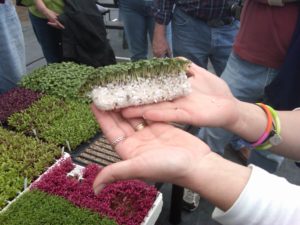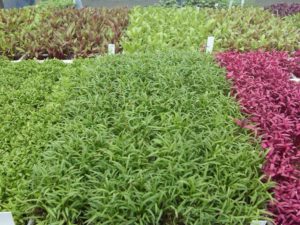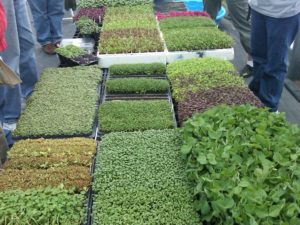What Are Microgreens?
go.ncsu.edu/readext?510181
en Español / em Português
El inglés es el idioma de control de esta página. En la medida en que haya algún conflicto entre la traducción al inglés y la traducción, el inglés prevalece.
Al hacer clic en el enlace de traducción se activa un servicio de traducción gratuito para convertir la página al español. Al igual que con cualquier traducción por Internet, la conversión no es sensible al contexto y puede que no traduzca el texto en su significado original. NC State Extension no garantiza la exactitud del texto traducido. Por favor, tenga en cuenta que algunas aplicaciones y/o servicios pueden no funcionar como se espera cuando se traducen.
Português
Inglês é o idioma de controle desta página. Na medida que haja algum conflito entre o texto original em Inglês e a tradução, o Inglês prevalece.
Ao clicar no link de tradução, um serviço gratuito de tradução será ativado para converter a página para o Português. Como em qualquer tradução pela internet, a conversão não é sensivel ao contexto e pode não ocorrer a tradução para o significado orginal. O serviço de Extensão da Carolina do Norte (NC State Extension) não garante a exatidão do texto traduzido. Por favor, observe que algumas funções ou serviços podem não funcionar como esperado após a tradução.
English
English is the controlling language of this page. To the extent there is any conflict between the English text and the translation, English controls.
Clicking on the translation link activates a free translation service to convert the page to Spanish. As with any Internet translation, the conversion is not context-sensitive and may not translate the text to its original meaning. NC State Extension does not guarantee the accuracy of the translated text. Please note that some applications and/or services may not function as expected when translated.
Collapse ▲Sprouts, microgreens, and baby greens are very young, tender plants, used as salads or garnishes on many types of dishes. Each of the names- sprouts, microgreens, and baby greens are all considered different products, as the plant is harvested for eating at different times. They can add color, texture, and interesting flavors to meals. Microgreens, in particular, are gaining popularity among chefs and more farmers are growing them. These are easy to grow and sprouts and microgreens can be grown indoors at home.
Sprouts are the youngest of the three. They are exactly as the name describes—seeds that have just germinated.  They may not have any green color to them. Typically, the entire plant is eaten including the shoots, the roots, and the seed, which may still be visible. Popular seeds for sprouting include mung beans, alfalfa, sunflower seeds, lentils, peas, mustards, and others. Sprouts can be grown in a simple sterilized jar, covered with a couple of inches of water, and then by a food grade cloth
They may not have any green color to them. Typically, the entire plant is eaten including the shoots, the roots, and the seed, which may still be visible. Popular seeds for sprouting include mung beans, alfalfa, sunflower seeds, lentils, peas, mustards, and others. Sprouts can be grown in a simple sterilized jar, covered with a couple of inches of water, and then by a food grade cloth
The real key with sprouts is sanitation. There is a risk of contamination with Salmonella and E. coli, which is often the result of contaminated seed. Commercial sprout operations must adhere to very strict sanitation standards but there have still been several outbreaks of illness from consuming commercial sprouts. Growing them at home does not mean they are safer since seeds are often the source of infection. Therefore it is very important to purchase seeds that are sold specifically for sprouting and that have been tested for the presence of microorganisms. Keep sprouts away from other food production areas and animals, and always wash hands thoroughly before setting up your sprouting operation.
Microgreens are the next size up from sprouts. The first green leaf-like structures to emerge on a seedling are called the cotyledons. The seedling has one or two cotyledons, and they are not typically the same shape as the leaves on the mature plant.  The leaf-like cotyledons may also be different colors such as purple or red. Microgreens are harvested for eating when the first leaf after the cotyledons, or the first true leaf, emerges. Many edible plants make excellent microgreens, including plants whose greens are not often consumed, such as carrots. Lettuces do not make good microgreens because they are too delicate. Common choices are broccoli, dill, basil, arugula, beets, and mustards, but there are many others. They each add a unique flavor and texture to any dish. The flavors are often similar to the mature version of the plant but tend to be more subtle.
The leaf-like cotyledons may also be different colors such as purple or red. Microgreens are harvested for eating when the first leaf after the cotyledons, or the first true leaf, emerges. Many edible plants make excellent microgreens, including plants whose greens are not often consumed, such as carrots. Lettuces do not make good microgreens because they are too delicate. Common choices are broccoli, dill, basil, arugula, beets, and mustards, but there are many others. They each add a unique flavor and texture to any dish. The flavors are often similar to the mature version of the plant but tend to be more subtle.
Growing your own microgreens at home is easy. Microgreens are grown in soilless potting media, such as a peat moss-based mix with vermiculite or perlite. To grow your own, put potting media from ½” to 1” into a sterile tray with drainage holes. Broadcast seeds across the entire tray or plant in rows and gently press into the media. Some seeds benefit from having a thin layer of media placed on top and others do not need it. Some harder seeds, like beets, will germinate more easily if they are soaked in water before sowing. Keep the seeds moist with a misting system until they germinate. After germination, keep moisture in the media from below the tray, either with a solid tray that holds water or with a food grade burlap cloth located under the media. Avoid watering the microgreens directly because this can encourage disease to develop.
Because they grow in media, do not eat the root. Instead, harvest microgreens by cutting the plant above the soil line when they are approximately 1.5-2.5” tall. Use clean scissors to cut them and gently scoop the harvested handfuls into a clean receptacle. The different plants used for microgreens vary in time from planting to harvest, but typically the process takes 7-21 days. It is easiest to sow only one cultivar in a tray but if you would like variety, consider planting cultivars that germinate and reach harvest stage in the same amount of time.
Baby greens are the next size up.  Plants used for baby greens are typically more familiar to us as greens- baby spinach, lettuces, kale, beet greens, and others. We only eat the leaves from baby greens and they are often used in salad or mesclun mixes. Unusual greens and herbs add different colors and flavors. Some to try might be amaranth greens or chervil. These are also relatively easy to grow, though unlike most microgreens, may require some fertilizer to reach the ideal size and quality.
Plants used for baby greens are typically more familiar to us as greens- baby spinach, lettuces, kale, beet greens, and others. We only eat the leaves from baby greens and they are often used in salad or mesclun mixes. Unusual greens and herbs add different colors and flavors. Some to try might be amaranth greens or chervil. These are also relatively easy to grow, though unlike most microgreens, may require some fertilizer to reach the ideal size and quality.
Next time you’re out at a restaurant or farmers’ market, look for microgreens and give them a try! If you like them, and enjoy growing things at home, consider growing a tray yourself, to add variety to winter cuisine. For more information on sprout safety and growing, see: The Food Safety of Sprouts factsheet from Clemson Cooperative Extension. For more information on growing microgreens, see this factsheet on Microgreens from the University of Florida Gardening Solutions collection. With any other questions about growing food at home or gardening, contact the N.C. Cooperative Extension, Caldwell County Center at 828-757-1290.




